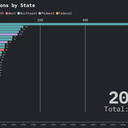The number of federal death sentences has increased in the past seven years, while the number of state death sentences has declined. The size of the federal death row has tripled since 2000, while the number of people on state death rows has dropped. There has also been a marked increase in the number of people on the federal death row from states that do not have their own death penalty laws.
From 1994 to 2000, there were 17 federal death sentences. From 2001 to 2007, there were 36 federal death sentences, while the annual number of state death sentences declined about 60% during this time. There were 19 inmates on the federal death row in 2000; today there are 57 inmates. The latest person to receive a federal death sentence is Rejon Taylor. A federal jury in Tennessee voted to impose a death sentence on Oct. 21, 2008. The judge is required to follow the jury’s verdict, but has not formally imposed the sentence. About 58% of the inmates on the federal death row are (like Taylor) members of minorities.
In 2000, all of the inmates on the federal death row were from states that had their own death penalty statutes. Today, there are 8 federal death row inmates from states that do not have the death penalty, including inmates from West Virginia, Iowa, Massachusetts, Michigan, Vermont, and North Dakota. (There is also one inmate from New York, which no longer has the death penalty but did at the time of the federal sentencing there.)
(From DPIC Statistics, Oct. 31, 2008). See Federal Death Penalty and Sentencing.



